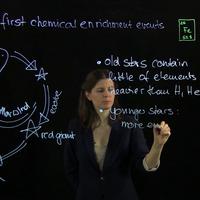Ep. 4: The First Chemical Enrichment Events
Have you ever wondered how all the chemical elements are made? Then join me
as we are lifting all the star dust secrets to understand the cosmic origin of the
chemical elements. We're now going to look at the first chemical enrichment
event, and how the universe recycles matter. Imagine that this is the
primordial gas leftover from after the Big Bang. And as we already said, the
first stars formed from this gas. So here is the first star, and stars are not
static objects they actually evolve with time which is an interesting thing and
we're going to look into more detail at that later but for now, we're just going
to say that they evolve, for example into something that's called
a red giant. Actually it's going to get much bigger.
What happens is that already during this evolutionary phase here,
stars have strong stellar winds. They can lose mass from their surface, and
whatever is in that gas that's being lost gets put back into the reservoir
here. If this is a massive star which is a given in the case of a first star,
this star is going to keep evolving until it explodes as a giant supernova
-- so it's an explosion of the star, the star gets completely disrupted -- and
naturally everything from the outer portions as well as the inner portions
of the star gets spilled out and put back into the reservoir.
Here we now have all the new elements from the core of the stars that have
been put in into the reservoir. Sometime later, after the death of
these first stars, this gas cloud is chemically enriched. Then, the next
generation of stars forms from this enriched material, they evolve, the
massive ones contribute new elements, make new elements, and contribute them,
low-mass stars -- they don't explode as supernovae -- they just keep sitting there
happily ever after pretty much so they do not contribute to this chemical
evolution cycle but all the massive stars with every new generation
contribute to a successive buildup of all the elements with time. Now, an
interesting consequence of that is that old stars have a lower overall abundance
of these heavy elements because they simply formed at a time when this cycle
here had only gone round a few times. So old stars contain little of the heavy
elements (heavier than hydrogen and helium) and consequently in younger stars
starting with the Sun and even younger than that, they contain a relatively
larger amount, so they are are more enriched. We already had it, the Sun has 1.4%
of all these heavy elements, and a star that would be born today would
have 2%. These old stars, however, compared to the Sun contain only a
millionth of what the Sun contains. A millionth of 1% -- that's a really
really small number. That really makes old-style stand out.
The issue for us is that we need to figure out a way how to measure the
element composition of our stars so that we can figure out: are there older or
younger which really means have they're formed early on in this cycle here or
much later. We equate that to old age or younger age but we do so without an
actual age measurement. So it's an inferred quantity for a quantity for now
but various independent tests have shown that this is a pretty good assumption
and that starts with very little of all the elements really are old and formed as
some of these very early generations. Now, in terms of the
nomenclature, we have to introduce one important term namely all stars well as
I said we don't really have an each measurement we just infer that it's
formed soon after the Big Bang and so what astronomers use is the term
metal-poor because that actually describes what the Stars composition is
it is poor in heavy elements of metals as astronomer thing and it is poor
compared to the Sun the Sun is our reference star the Sun has 1.4 percent
of metal and our our all cells from the early universe contain only a tiny tiny
fraction of this year and so we call them metal poor and when you look for
the oldest stars or want to look for the older stuff what you actually have to do
is you have to search for the most metal poster
Oh

